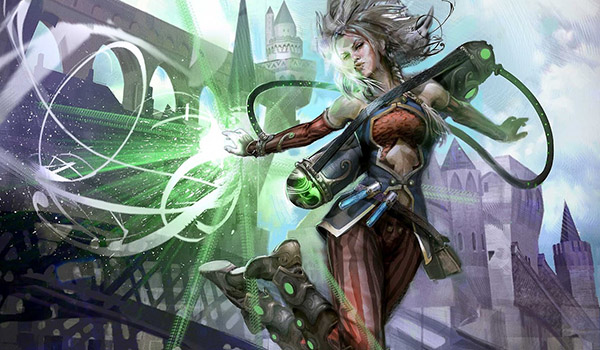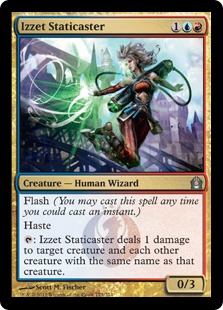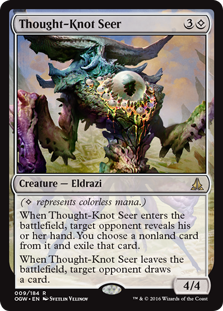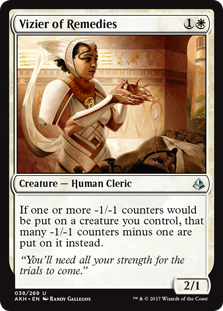Are you a Quiet Speculation member?
If not, now is a perfect time to join up! Our powerful tools, breaking-news analysis, and exclusive Discord channel will make sure you stay up to date and ahead of the curve.
Five weeks ago, I made some bold predictions about where I thought Modern was headed for the summer of 2017. Fresh off SCG Baltimore, Modern was firmly in the grasp of Grixis Death’s Shadow, as the format was just beginning to warp around it. Today, we’ll look at those predictions to determine what I got right (or wrong), and to take state of the format as it stands today.

Breaking Down the Data
The premise of “A Look Ahead: Predicting Modern Five Weeks From Now” was simple: in an attempt to challenge my grasp of the format and how it reacts to new information, I chose to put myself under the lights, predicting a possible future based on all information I had at the time. Before we figure out if I got things right, let’s recap my predictions from the beginning of June.
I outlined two possible scenarios, but chose to stick to one: that Grixis Death’s Shadow would adapt to widespread hate in the format, establish itself as a permanent player in the field, and lower Eldrazi Tron's shares as a result. In the absence of Eldrazi Tron, the floodgates would be opened to a variety of “new” archetypes that were kept in check by the midrange menace. Here is what I said then:
It is my belief that Grixis Death’s Shadow will not remain on top for long, but before it falls from its throne Grixis will see the format shift around it in a meaningful way. While five weeks is a short enough time to see a small shift back to the way things were before Modern weekend, I believe that Counter Company as a new archetype in the format will force decks to prioritize cheap removal highly, which will continue to play into Grixis’ hands. If more players pick up the deck, which is likely given its strong performance, and said players choose to target Eldrazi Tron with their sideboards, we could see the format stress test take a significant hit.
A diminished Eldrazi Tron would allow multiple strategies into the fold that will in turn diversify the threats against Grixis Death’s Shadow, causing its decline (but overall, an increase in format health). Who comes out on top is hard to tell, and frankly, not really that important. Still, I’m banking on Eldrazi Tron diminished five weeks from now, midrange back in the fold, and a more diverse metagame across the board. This thanks to Grixis Death’s Shadow, which owes its thanks to Counters Company, which owes its thanks to Eldrazi Tron. The circle is now complete.
So, how did I do? Keep in mind how things looked five weeks ago. With SCG Baltimore in the books, and SCG Charlotte impending, Grixis Death’s Shadow was at the forefront of everyone’s minds, and a solution had yet to be found. Now, we know what happened; Hatebears came out of nowhere to punish a Grixis Death’s Shadow archetype that had folded in on itself in an attempt to beat the mirror. By exposing a self-made weakness thanks to a lack of Lightning Bolt, Standard all-star Mirran Crusader took a weekend’s worth of events by storm, and unseated Grixis Death’s Shadow from the throne. Hatebears was able to capitalize on a preoccupied “bad matchup,” and pounced. Thanks to a solid matchup against Eldrazi Tron, Hatebears took over an unsuspecting field.
 But, as we now know, Hatebears was then easily hated back out of the format. All it took was a few more Izzet Staticaster, a couple extra Lightning Bolt, a return to Anger of the Gods, and a re-sleeving of red removal. Grixis Death’s Shadow did what it always does—adapted—and Hatebears retreated back into obscurity. In its place, non-Shadow midrange came out in full force. Jeskai Control, RW Prison, UW Control, and a whole slew of Bx midrange strategies took its place, unseating Eldrazi Tron during the four-event weekend I covered in my last article. Death’s Shadow returned, but in a variety of flavors; Classic, Grixis, even Esper made an appearance.
But, as we now know, Hatebears was then easily hated back out of the format. All it took was a few more Izzet Staticaster, a couple extra Lightning Bolt, a return to Anger of the Gods, and a re-sleeving of red removal. Grixis Death’s Shadow did what it always does—adapted—and Hatebears retreated back into obscurity. In its place, non-Shadow midrange came out in full force. Jeskai Control, RW Prison, UW Control, and a whole slew of Bx midrange strategies took its place, unseating Eldrazi Tron during the four-event weekend I covered in my last article. Death’s Shadow returned, but in a variety of flavors; Classic, Grixis, even Esper made an appearance.
Just look at the main theme of last weekend’s results:
First, while the established non-Shadow midrange decks (Abzan and Jund) put up uninspiring results individually, collectively the macro-archetype performed well, especially considering the narrative that Eldrazi Tron has been pushing midrange out of the fold. While Abzan and Jund account for only 50% of the midrange representation, BG, Death and Taxes, and BW Smallpox each make a case for midrange succeeding in Modern, albeit in unconventional forms. Going further, you can make a case for the RW Prison deck as midrange as well, along with Kevin Jones’s Jeskai Control list, which makes use of large amounts of burn and Spell Queller.
The numbers from last weekend suggest that times are changing. Where midrange was once entirely absent from the picture, it has now returned to occupy an even share of the frame. If we group Death’s Shadow decks with midrange (as it is, in fact, the best midrange deck), we can easily see that the macro-archetype is back in a big way—but to be truthful, it never really left. Midrange was always present in Modern, in the form of Eldrazi Tron itself. Death’s Shadow is midrange; Eldrazi Tron is midrange; basically, everything in Modern that isn’t spell-based combo or creature aggro is midrange at this point. Still, the narrative that Eldrazi Tron was pushing “other” midrange decks out of the picture was true; as Eldrazi Tron diminished, these archetypes returned. BG Midrange, RW Prison, Smallpox, Abzan, Jund, and other such archetypes crawled out of the caves they were hiding in two weeks ago, offering some measure of validity to the idea that Eldrazi Tron had kept them from success.
 So, it seems that my prediction about Eldrazi Tron’s decline was fulfilled two weeks ago, but what does that mean for now? With no major events recently (besides the four events from the beginning of July), all we have to go off of is Modern League finishes and aggregated MTGO data. MTGGoldfish still shows Eldrazi Tron grabbing a significant portion of the finishes, but only six copies were able to put up Modern League finishes in the past two weeks. This suggests to me that Eldrazi Tron’s numbers are shrinking, and its metagame percentage will continue to diminish as those old finishes fall out of scope.
So, it seems that my prediction about Eldrazi Tron’s decline was fulfilled two weeks ago, but what does that mean for now? With no major events recently (besides the four events from the beginning of July), all we have to go off of is Modern League finishes and aggregated MTGO data. MTGGoldfish still shows Eldrazi Tron grabbing a significant portion of the finishes, but only six copies were able to put up Modern League finishes in the past two weeks. This suggests to me that Eldrazi Tron’s numbers are shrinking, and its metagame percentage will continue to diminish as those old finishes fall out of scope.
In its place, what do we see putting up results? Jeskai Control. Lantern Control. Esper. Abzan. UW. Unlike Hatebears, which put up impressive results for a week only to vanish afterwards, the midrange decks that made an appearance two weeks ago are continuing to put up results. Non-Grixis Death’s Shadow, non-Eldrazi Tron midrange is back, and for now, it seems its here to stay.
Trust the Numbers?
Up to this point, my conclusions have all been based on results that have played out over the last few weeks, which puts us in an interesting position regarding ‘legitimacy’. While the numbers suggest that Eldrazi Tron is on the decline, and other midrange decks are on the rise, it’s difficult to tell based on a couple weeks' worth of numbers whether this is a true indicator of the direction the format is moving, or just of some short-term trends that coincidentally line up to support my narrative. For example, next week we could see Counters Company and/or Hatebears come back into the discussion, and the format would look entirely different.
 From my perspective, these risks in data analysis are always present, no matter the situation. Whether we’re looking at an event’s worth of data, a month’s, or even a whole year's, it’s always possible that outliers are to blame for influencing the results that we see. Counters Company players might have taken a week off, for example. Is five weeks really enough time to make substantial claims about the format and the direction that its heading?
From my perspective, these risks in data analysis are always present, no matter the situation. Whether we’re looking at an event’s worth of data, a month’s, or even a whole year's, it’s always possible that outliers are to blame for influencing the results that we see. Counters Company players might have taken a week off, for example. Is five weeks really enough time to make substantial claims about the format and the direction that its heading?
I think the answer to that question is murky, so I’ll just leave it at this: if we can make claims about format direction after just a weekend’s events worth of data, we should feel confident in our claims by looking at five times that information. Counters Company could just be laying low, or “waiting for the right list,” or getting overshadowed by other decks, but it’s been a month now and we’re not seeing results. How much time do we give it before moving on? If the deck could really challenge the format in a specific way, I think we would be seeing it put up Top 16s, at least. There exists a contingent in every format that will give any deck a try. I don’t buy in to the narrative that it’s a deck worthy of putting up strong results that people just aren’t giving a chance. Still.
The deck is capable of winning games in Modern, don’t get me wrong. I’m not disputing that—it has proven itself on that front. I don’t argue that Skred can’t win games, but we all agree that Skred isn’t influencing the format in any particular way. Counters Company is clearly ahead of Skred in the sense that it has a proven pedigree of impressive finishes, but the deck is still “brand new” and hasn’t answered the most important question in Modern yet: can it stand the hate? Until that happens, and we see Counters Company succeed in a prepared field, I’m not ready to give it a pass without finishes in a weekend event.
Conclusion
So Counters Company failed to secure any significant portion of the metagame, and for now it looks like it's gone for good, at least in the short term. The time for a creature combo deck like that to succeed has passed, as removal and reaction is once again the key to Modern. While I’m not quite ready to look ahead just yet, a wide-open field of midrange decks jockeying for position will inevitably initiate an arms race of value, as each deck attempts to go bigger in the hopes of gaining an edge in the midrange mirrors. Look for sideboards to get more and more greedy, and these strategies to become increasingly more inbred, until a well-tuned, powerful archetype takes the bottom out from under the field. Will it be Affinity? Dredge? Burn? Merfolk? It’s too early to say, but make no mistake, it will happen. The question is, will you be ready for it? Thanks for reading, and I’ll see you next week.
Trevor Holmes






I think you’re jumping through some hoops to make things midrange. But I see what you’re getting at. Dnt wa sdefinitely hard to predict coming to the forefront.